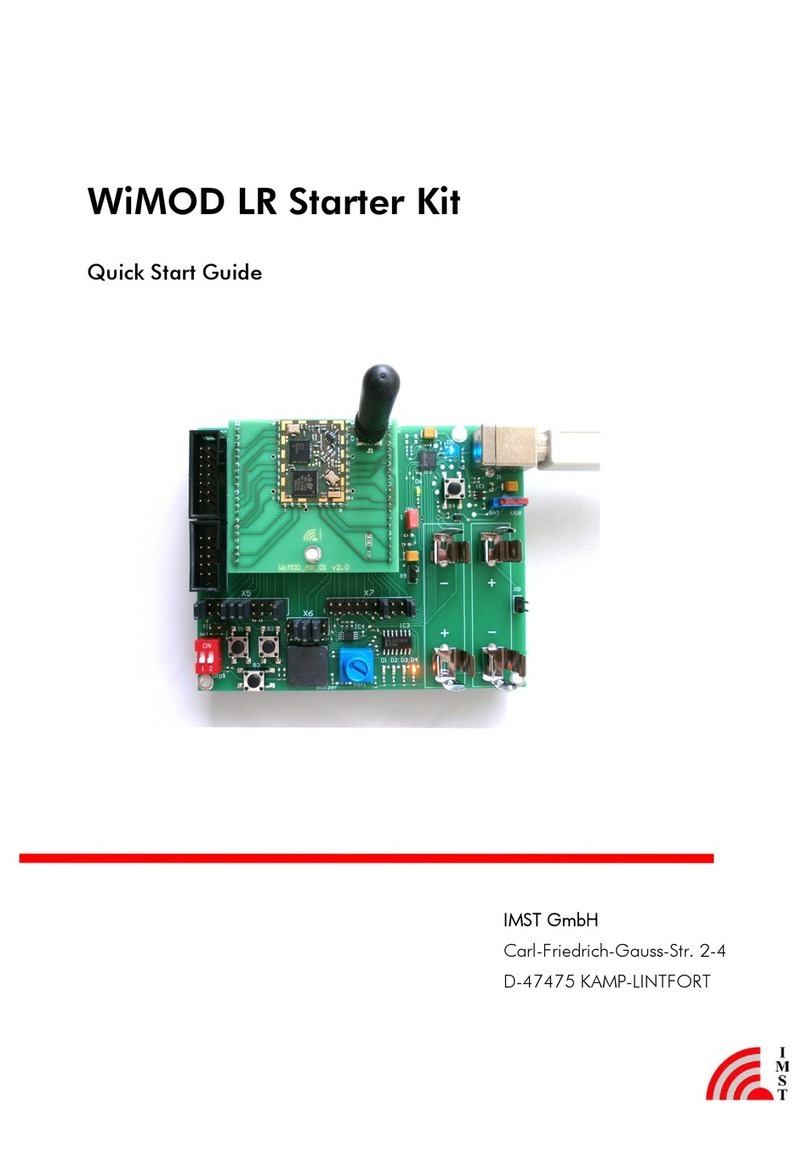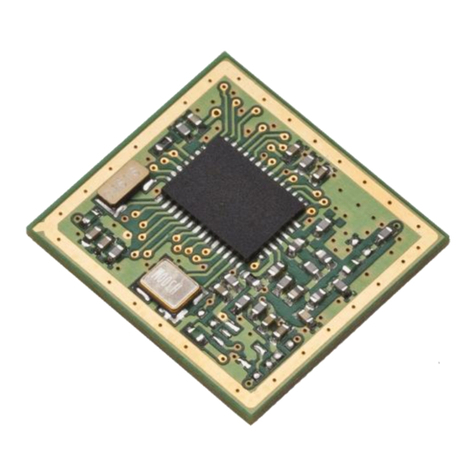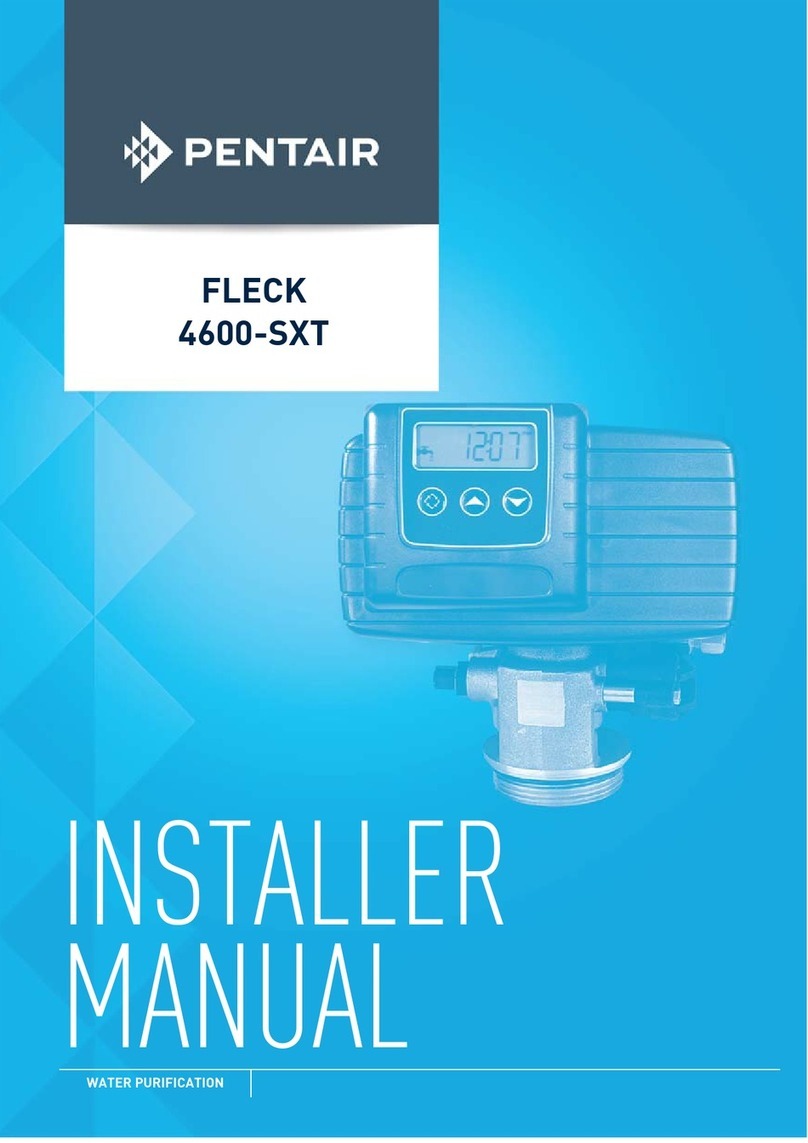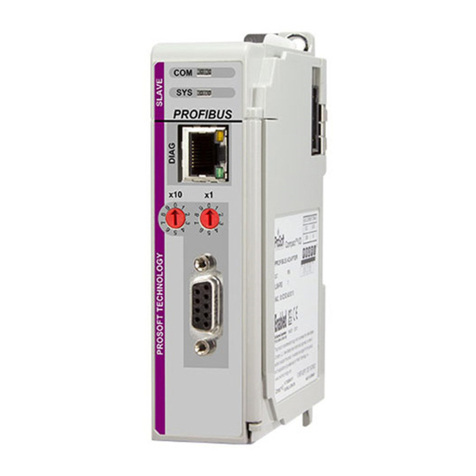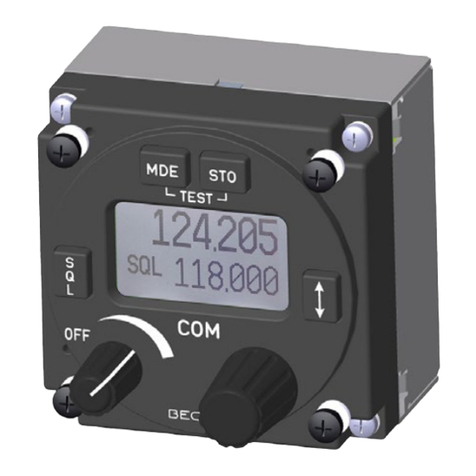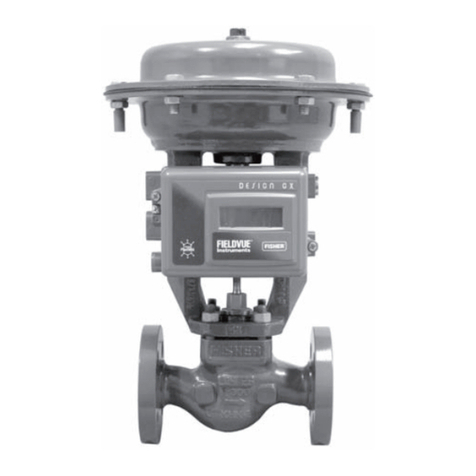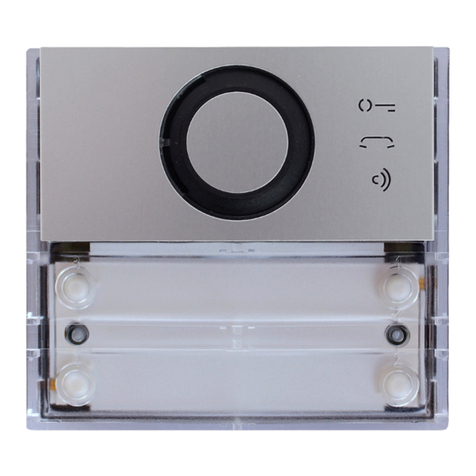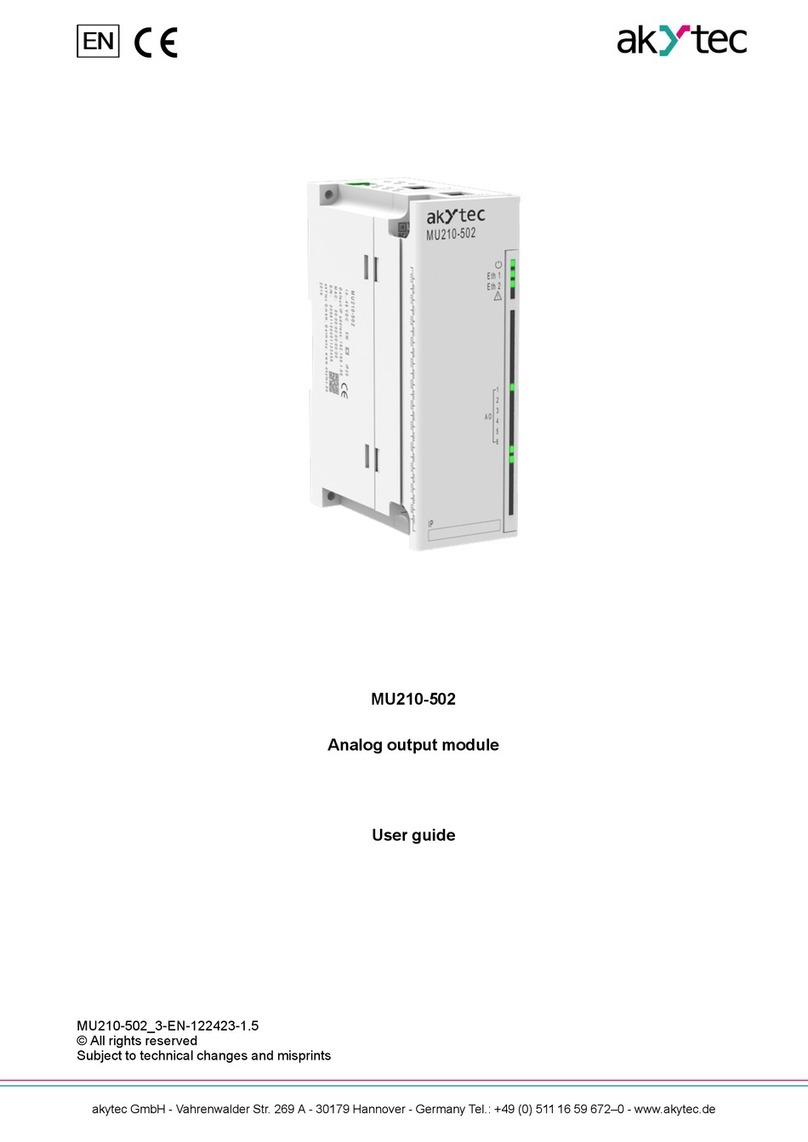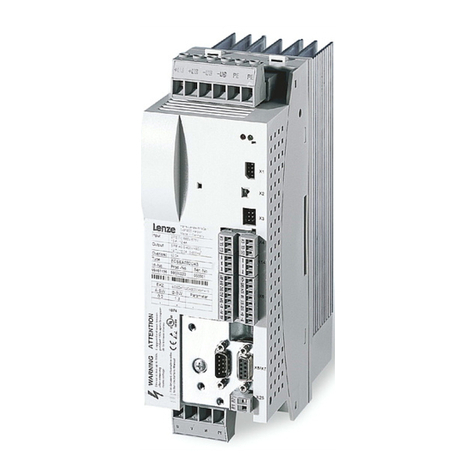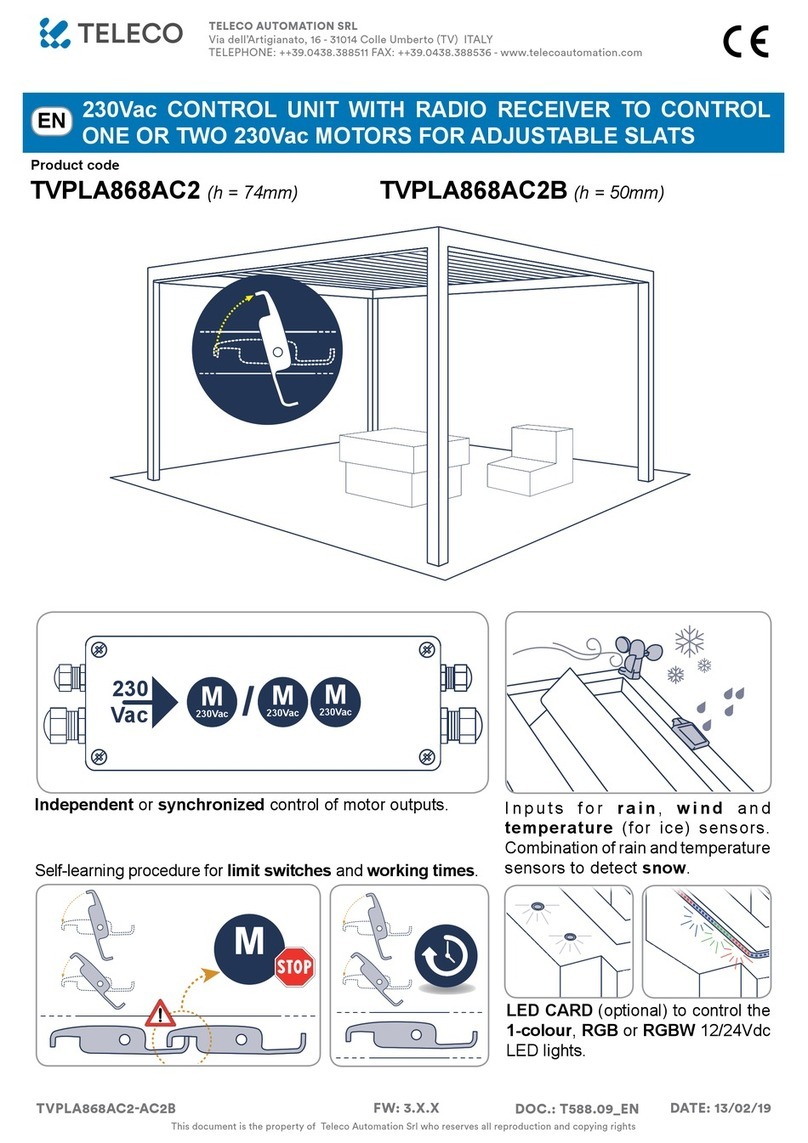IMST iC880A User manual

iC880A QuickStart Guide
How to get started with the iC880A
Document ID: 4100/40140/0078
Category: confidential
IMST GmbH
Carl-Friedrich-Gauss-Str. 2-4
D-47475 Kamp-Lintfort

iC880A QuickStart Guide - QuickStart Guide
Precaution: Important note confidential
iC880A_QuickStartGuide.docx, Wireless Solutions, V0.6 page 2 of 15
Document Information
File name
iC880A_QuickStartGuide.docx
Created
2015-03-15
Total pages
15
Revision History
Version
Description
0.1
Preliminary version.
0.2
Figure 2.1 updated
0.3
Added information about the polarity of the DC-Jack / Power supply connector
0.4
Picture of iC880A updated
0.5
Added version information about the referenced github repository; added hint about the WiMOD
LR Studio
0.6
Changed link URL to libmpsse
Aim of this Document
Aim of this document is to give some quick start instructions how to start working with the
WiMOD iC880A.
Confidentiality Note
This document has to be treated confidentially. Its content must not be published, duplicated or
passed to third parties without our express permission.

iC880A QuickStart Guide - QuickStart Guide
Precaution: Important note confidential
iC880A_QuickStartGuide.docx, Wireless Solutions, V0.6 page 3 of 15
Table of Contents
1PRECAUTION: IMPORTANT NOTE 4
2OVERVIEW 4
2.1 Hardware PCB 4
2.2 Basic System Concept 5
2.3 Linux Host System 6
2.4 Hardware Connection 6
3OPEN SOURCE DRIVER ON GITHUB 6
3.1 Download of the Open Source Driver 7
3.2 Downloading Additional Drivers 7
3.3 Configuration of the Driver 8
3.3.1 File: lora_gateway/libloragw/library.cfg 8
3.3.2 File: lora_gateway/libloragw/src/loragw_spi.ftdi.c 9
3.4 Compilation of the Library 9
3.5 Setting up “udev” Rules 9
3.6 Connection of iC880A and the Linux Host 10
3.7 Example Utilities 10
3.7.1 util_tx_test 10
3.7.2 util_pkt_logger 11
4NEXT STEPS 13
5REGULATORY COMPLIANCE INFORMATION 14
6IMPORTANT NOTICE 15
6.1 Disclaimer 15
6.2 Contact Information 15

iC880A QuickStart Guide - QuickStart Guide
Precaution: Important note confidential
iC880A_QuickStartGuide.docx, Wireless Solutions, V0.6 page 4 of 15
1Precaution: Important note
Caution: Before connecting the iC880A to an external power supply, please read this note
carefully!
The WiMOD iC880A concentrator is a versatile device that needs extra power to operate
properly. The USB specification allows a device to draw up to 500 mA in normal operation
conditions. Within the defined performance range the concentrator needs more than 500 mA.
Depending on your Linux host that is to be connected with the iC880A, the USB interface cannot
supply enough power. Therefore an external power supply is highly recommended.
When using an external power supply a certain order of connecting the cables must be followed:
1) First: power up the iC880A with an external power supply
2) Second: connect the USB cable between the iC880A and the host.
Make sure the external power supply is on and supplies 5 V before connecting the power cable.
If there is no power available and the connector is in the DC jack, the internal voltage regulators
of the iC880A may get damaged!
The polarity of the external DC-Jack is shown in Figure 1-1:
Figure 1-1 Polarity of the 5V DC-Jack
2Overview
Purpose of this documentation is to give some useful information how to start developing your
own software based on the open source LoRa HAL published on the github platform.
The concentrator module iC880A is meant to be connected to a host system forming an
integrated gateway.
2.1 Hardware PCB
Figure 2-1 depicts the printed circuit board of the iC880A. As main interfaces there are the DC
–Power Jack and the USB-Connector to a host system that runs the driver software. A SMA
connector is supplied in order to connect any suitable antenna to this board. The board offers
some LEDs to give a visual feedback of the current operation status of the board. The concrete
meaning of the LEDs is software dependant. As default setting the LEDs is:

iC880A QuickStart Guide - QuickStart Guide
Overview confidential
iC880A_QuickStartGuide.docx, Wireless Solutions, V0.6 page 5 of 15
1) Backhaul packet
2) TX packet
3) RX Sensor packet
4) RX FSK packet
5) RX buffer not empty
6) Power
Sx1301
Status LEDs
1
2
3
4
5
6
868MHz Antenna
Connector ufl
Optional GPS
Receiver
Sx1257, radio_0, radio_1
Power
Supply
USB Interface
Figure 2-1Picture of iC880A-USB
2.2 Basic System Concept
Figure 2-2 shows the basic system concept for the LoRA WAN system. The iC880A is the central
hardware solution for all LoRa based radio communication. It receives and transmits radio
messages. Processing of the radio messages as well as the protocol related tasks is done by
(external) host system(s). The concrete segmentation of the protocol related tasks is outside the
scope of this document.

iC880A QuickStart Guide - QuickStart Guide
Open Source Driver on Github confidential
iC880A_QuickStartGuide.docx, Wireless Solutions, V0.6 page 6 of 15
Figure 2-2: Basic System Concept
2.3 Linux Host System
As a host system an (embedded) Linux host system is planned to be used. This quick start guide
assumes that the user has got an (embedded) Linux host system (e.g. Raspberry PI, or similar), is
familiar with the basic concept of a Linux console and knows how to compile source code. All
commands shown in this document are tested with a Debian 8 “Jessie” Linux distribution on a
Raspberry PI B+. It is possible to use any other host system and Linux distribution, but there may
be some variations in the commands, that are not within the scope of this document.
The basic setup of the (embedded) Linux host system (keyboard layout, time zone, network
connectivity, accessibility, …) is outside of the scope of this document, too.
2.4 Hardware Connection
The iC880A provides a mini USB connector as main interface to the Linux host system. Before
connecting the iC880A and the host, please read this document carefully. In order to establish a
logical connection the host needs to have some drivers installed.
3Open Source Driver on Github
Semtech provides an open source driver for SX1301 based LoRa solutions. The complete
repository is hosted on the github platform ( https://github.com/ ).

iC880A QuickStart Guide - QuickStart Guide
Open Source Driver on Github confidential
iC880A_QuickStartGuide.docx, Wireless Solutions, V0.6 page 7 of 15
The main vanilla source repository for the LoRa related projects maintained by Semtech can be
found at:
https://github.com/Lora-net
There you will find an implementation for the HAL (Hardware Abstraction Layer) of SX1301based
designs. This implementation is called "lora_gateway" (https://github.com/Lora-
net/lora_gateway ). This document references to version 1.7 of the lora_gateway repository.
Newer versions of this software may behave differently or may require a different configuration.
Changes / updates within all relevant software repositories are subject to change without notice.
3.1 Download of the Open Source Driver
Install a git client on your (embedded) host system: On Debian based systems the git client can
be installed by calling the following command in a terminal emulator / console:
sudo apt-get install git
Create local folder that should contain the local copy of the repository:
mkdir -p ~/LoRa/lora_gateway
Get a copy of the repository:
cd ~/LoRa/lora_gateway
git clone https://github.com/Lora-net/lora_gateway.git
3.2 Downloading Additional Drivers
The iC880A device is connected to an (embedded) Linux host system via an USB link. In order to
establish a local USB link, a driver called “libmpsse” must be installed on the host system.
Create a folder for the libmpsse files:
mkdir –p ~/LoRa/libmpsse
Download the newest version of the libmpsse files:
cd ~/LoRa/libmpsse
wget https://storage.googleapis.com/google-code-archive-
downloads/v2/code.google.com/libmpsse/libmpsse-1.3.tar.gz
tar –xzvf libmpsse-1.3.tar.gz

iC880A QuickStart Guide - QuickStart Guide
Open Source Driver on Github confidential
iC880A_QuickStartGuide.docx, Wireless Solutions, V0.6 page 8 of 15
Follow the installation instructions from the hosted website:
https://code.google.com/p/libmpsse/wiki/Installation:
sudo apt-get install libftdi-dev
cd ~/LoRa/libmpsse/libmpsse-1.3/src
./configure --disable-python && make && sudo make install
sudo ldconfig
If the configure step fails, follow the instructions and try to install the missing dependencies.
3.3 Configuration of the Driver
The driver must be configured in order to work with the iC880A. The following chapter describes
the necessary configuration options to make.
In the folder “LoRa/github/lora_gateway/libloragw” there is a file called
“libraray.cfg”. This file contains the most important options for the HAL-library and must
be modified to your needs before compiling the software.
3.3.1 File: lora_gateway/libloragw/library.cfg
This file is used as general configuration file for the whole libloragw system library. In order
to fit the needs of the iC880A, some parameters must be set to the following values prior (re-)
compiling the library:
CFG_SPI= ftdi
CFG_CHIP= sx1301
CFG_RADIO= sx1257
CFG_BAND= eu868
The parameter called “CFG_BRD” must be left empty or set to:
CFG_BRD= ref_1301_868
Additionally there are some optional debug settings that can be turned on (1) or off (0):
DEBUG_AUX= 0
DEBUG_SPI= 0
DEBUG_REG= 0
DEBUG_HAL= 1
DEBUG_GPS= 0
These flags are used by the internal modules of the library to enable / disable additional output
for debugging purposes.

iC880A QuickStart Guide - QuickStart Guide
Open Source Driver on Github confidential
iC880A_QuickStartGuide.docx, Wireless Solutions, V0.6 page 9 of 15
3.3.2 File: lora_gateway/libloragw/src/loragw_spi.ftdi.c
As second step a small modification must be done in one of the low level connection files. The
WiMOD iC880A LoRa Concentrator board uses a FTDI USB to SPI converter chip that is not
supported in Semtech’s reference code. The only difference is another USB PID. Therefore the
USB PID settings in the libloragw library have to be adjusted prior compiling the library.
Open the file lora_gateway/libloragw/src/loragw_spi.ftdi.c with your favorite editor (e.g. nano)
nano lora_gateway/libloragw/src/loragw_spi.ftdi.c
Find the block with the “PRIVATE CONSTANTS” (around line 50 in the file) and change the
line
#define PID 0x6010
to
#define PID 0x6014
Afterwards save the file and close the editor.
3.4 Compilation of the Library
In order to compile the libloragw library it is assumed that a gcc/g++ compiler and a make
utility is already installed and runable.
Enter the lora_gateway folder and execute the make command:
cd lora_gateway
make
This will compile the library and some of the basic test utilities located in the subfolders of
lora_gateway.
After a successful compilation a library file called “libloragw.a”has been created and is
ready for usage now.
3.5 Setting up “udev”Rules
The FTDI USB chip needs to be run in the SPI mode. Therefore an “udev”rule must be installed
on the Linux host system. This rule will configure the right mode automatically when the iC880A
device is connected to the host system. In order to install the udev rule the following steps must
be done:

iC880A QuickStart Guide - QuickStart Guide
Open Source Driver on Github confidential
iC880A_QuickStartGuide.docx, Wireless Solutions, V0.6 page 10 of 15
In the folder lora_gateway/libloragw there is a template file present. Open the file in
your favorite editor (e.g. nano).
nano lora_gateway/libloragw/99-libftdi.rules
locate the line
SUBSYSTEM=="usb",ENV{DEVTYPE}=="usb_device",
ATTRS{idVendor}=="0403", ATTRS{idProduct}=="6010",
MODE="0664", GROUP="plugdev"
and change the entry
ATTRS{idProduct}=="6010”
to:
ATTRS{idProduct}=="6014”
Save the file and leave the editor. Next copy the file to the folder /etc/udev/rules.d/
sudo cp 99-libftdi.rules /etc/udev/rules.d/
3.6 Connection of iC880A and the Linux Host
3.7 Example Utilities
In the folder lora_gateway there are several example utilities showing the usage of the
libloragw library. This quick start guide will show the “util_pkt_logger” and the
“util_tx_test”.
3.7.1 util_tx_test
This is a small utility demonstrating the ability to send out some data via the iC880A
concentrator device. To start this utility go into the folder and start it:
cd lora_gateway/util_tx_test
./util_tx_test
The program should start and print out some output like that:

iC880A QuickStart Guide - QuickStart Guide
Open Source Driver on Github confidential
iC880A_QuickStartGuide.docx, Wireless Solutions, V0.6 page 11 of 15
Sending -1 packets on 866500000 Hz (BW 125 kHz, SF 10, CR 1,
16 bytes payload, 8 symbols preamble) at 14 dBm, with 1000 ms
between each
INFO: concentrator started, packet can be sent
Sending packet number 1 ...OK
Sending packet number 2 ...OK
Sending packet number 3 ...OK
Each time a new packet is being transmitted the TX-LED of the iC880A should flash. The tool
can be stopped by pressing the key combination Ctrl+C. For more information about this tool,
please consult the online help by calling:
./util_tx_test --help
3.7.2 util_pkt_logger
This utility tool is able to demonstrate the receiving ability of the iC880A device. It configures the
iC880A device for RX operation and writes each received packet into a CSV file. That file can be
opened and inspected afterwards.
This tool needs a configuration file that holds parameters relevant to the RX operation of the
concentrator. Please take a look into this file called global_conf.json .
An example global_conf.json looks like that:
{
"SX1301_conf": {
"radio_0": {
"enable": true,
"freq": 868200000
},
"chan_multiSF_0": {
/* LoRa MAC channel, 125kHz, all SF, 868.1 MHz */
"enable": true,
"radio": 0,
"if": -100000
},
"chan_multiSF_1": {
/* LoRa MAC channel, 125kHz, all SF, 868.3 MHz */
"enable": true,
"radio": 0,
"if": 100000
},
"chan_multiSF_2": {
/* LoRa MAC channel, 125kHz, all SF, 868.5 MHz */
"enable": true,
"radio": 0,
"if": 300000
},
"chan_Lora_std": {
/* LoRa MAC channel, 250kHz, SF7, 868.3 MHz */
"enable": true,
"radio": 0,
"if": 100000,

iC880A QuickStart Guide - QuickStart Guide
Open Source Driver on Github confidential
iC880A_QuickStartGuide.docx, Wireless Solutions, V0.6 page 12 of 15
"bandwidth": 250000,
"spread_factor": 7
},
"chan_FSK": {
/* FSK 100kbps channel, 868.3 MHz */
"enable": true,
"radio": 0,
"if": 100000,
"bandwidth": 250000,
"datarate": 100000
}
},
"gateway_conf": {
"gateway_ID": "AA555A0000000000"
}
}
In the head of the file there is one config block for each radio of the concentrator. Each radio
can be turned on / off and operates on a certain base frequency. (See block “radio_0” and
“radio_1”). The following blocks define the parameters used by the virtual multi SF channels.
Each logical channel configuration consists of the radio to be used and the RF frequency. The
RF frequency is defined as difference to the base frequency defined in the corresponding radio
config block.
After checking the configuration the tool can be started via:
cd lora_gateway/util_pkt_logger
./util_ptk_logger
After starting the packet logger, please send out some data with another radio module. In this
document it is assumed that the user is familiar with the WiMOD iM88xA radio module or the
iU88xA USB-Stick and the Windows Software called “WiMOD LR Studio”
1
or “WiMOD ExpLoRa
Studio” or “WiMOD LoRaWAN EndNode Studio”.
In order to send some data start the Windows software and navigate to “Configuration” and
make sure the TX setup matches one of the configurations in the global_conf.json file
within the util_pkt_logger folder on the linux host. After setting up the radio TX
configuration, navigate to “Radio Services”/ “Data Link Service”and start sending some test
messages.
In order to inspect the RX data from the iC880A device stop the util_pkt_logger by
pressing Ctrl+C and open the CSV file in the current folder.
The following screen shot shows the TX and RX data:
1
The WiMOD LR Studio is intended to be used with a WiMOD Module running the WiMOD LR-Base firmware. The
other PC software is intended to be used in conjunction with a WiMOD Module running the WiMOD LoRaWAN
firmware.

iC880A QuickStart Guide - QuickStart Guide
Next Steps confidential
iC880A_QuickStartGuide.docx, Wireless Solutions, V0.6 page 13 of 15
Figure 3-1: Screen shot of the recorded CSV file and the WiMOD LR studio
Note: The CSV file records all data as hexadecimal bytes with no respect to any fields defined in
the LoRa WAN specification. Therefore you have to look at the end of the payload within the
CSV file to see the payload data message itself.
4Next Steps
After stepping through this guide the user is able to start developing his/her own iC880A based
solution.
As a final hint there are some more interesting open source projects within the gitbub repository
https://github.com/Lora-net/
For example there is a project called “packet_forwarder” that demonstrates how to receive LoRa
packets and forward the data to a remote server which may run a LoRa WAN Server
implementation or any other proprietary solution.
For more information please refer to the User Guides and specific data sheets of the
corresponding products.

iC880A QuickStart Guide - QuickStart Guide
Regulatory Compliance Information confidential
iC880A_QuickStartGuide.docx, Wireless Solutions, V0.6 page 14 of 15
5Regulatory Compliance Information
The use of radio frequencies is limited by national regulations. The radio module has been
designed to comply with the European Union’s R&TTE (Radio & Telecommunications Terminal
Equipment) directive 1999/5/EC and can be used free of charge within the European Union.
Nevertheless, restrictions in terms of maximum allowed RF power or duty cycle may apply.
The radio module has been designed to be embedded into other products (referred as “final
products”). According to the R&TTE directive, the declaration of compliance with essential
requirements of the R&TTE directive is within the responsibility of the manufacturer of the final
product. A declaration of conformity for the radio module is available from IMST GmbH on
request.
The applicable regulation requirements are subject to change. IMST GmbH does not take any
responsibility for the correctness and accuracy of the aforementioned information. National laws
and regulations, as well as their interpretation can vary with the country. In case of uncertainty, it
is recommended to contact either IMST’s accredited Test Center or to consult the local
authorities of the relevant countries.
This Development Kit/Starter Kit does not fall within the scope of the European Union directives
regarding electromagnetic compatibility, restricted substances (RoHS), recycling (WEEE), FCC,
CE or UL, and therefore may not meet the technical requirements of these directives or other
related directives.

iC880A QuickStart Guide - QuickStart Guide
Important Notice confidential
iC880A_QuickStartGuide.docx, Wireless Solutions, V0.6 page 15 of 15
6Important Notice
6.1 Disclaimer
IMST GmbH points out that all information in this document is given on an “as is” basis. No
guarantee, neither explicit nor implicit is given for the correctness at the time of publication.
IMST GmbH reserves all rights to make corrections, modifications, enhancements, and other
changes to its products and services at any time and to discontinue any product or service
without prior notice. It is recommended for customers to refer to the latest relevant information
before placing orders and to verify that such information is current and complete. All products
are sold and delivered subject to “General Terms and Conditions” of IMST GmbH, supplied at
the time of order acknowledgment.
IMST GmbH assumes no liability for the use of its products and does not grant any licenses for
its patent rights or for any other of its intellectual property rights or third-party rights. It is the
customer’s duty to bear responsibility for compliance of systems or units in which products from
IMST GmbH are integrated with applicable legal regulations. Customers should provide
adequate design and operating safeguards to minimize the risks associated with customer
products and applications. The products are not approved for use in life supporting systems or
other systems whose malfunction could result in personal injury to the user. Customers using the
products within such applications do so at their own risk.
Any reproduction of information in datasheets of IMST GmbH is permissible only if reproduction
is without alteration and is accompanied by all given associated warranties, conditions,
limitations, and notices. Any resale of IMST GmbH products or services with statements different
from or beyond the parameters stated by IMST GmbH for that product/solution or service is not
allowed and voids all express and any implied warranties. The limitations on liability in favor of
IMST GmbH shall also affect its employees, executive personnel and bodies in the same way.
IMST GmbH is not responsible or liable for any such wrong statements.
Copyright © 2015, IMST GmbH
6.2 Contact Information
IMST GmbH
Carl-Friedrich-Gauss-Str. 2-4
47475 Kamp-Lintfort
Germany
T+49 2842 981 0
F+49 2842 981 299
Iwww.wireless-solutions.de
Table of contents
Other IMST Control Unit manuals
Popular Control Unit manuals by other brands
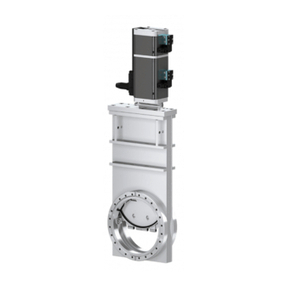
VAT
VAT 10.8 Series Installation, operating, & maintenance instructions
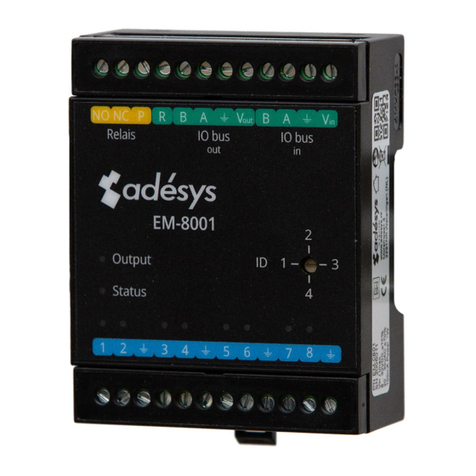
Adesys
Adesys Octalarm EM-8001 quick start
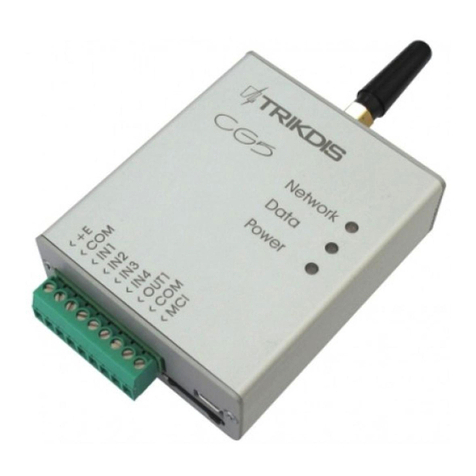
Trikdis
Trikdis CG5 installation manual
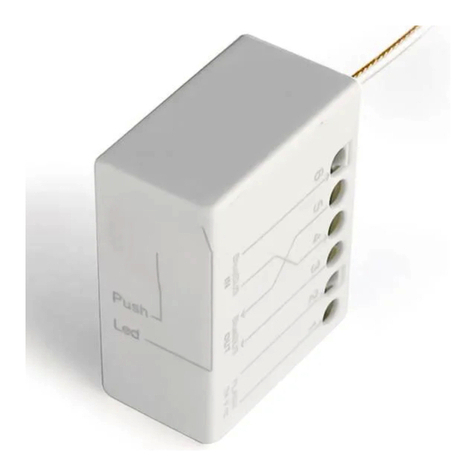
Nice
Nice WM100 Instructions and warnings for installation and use
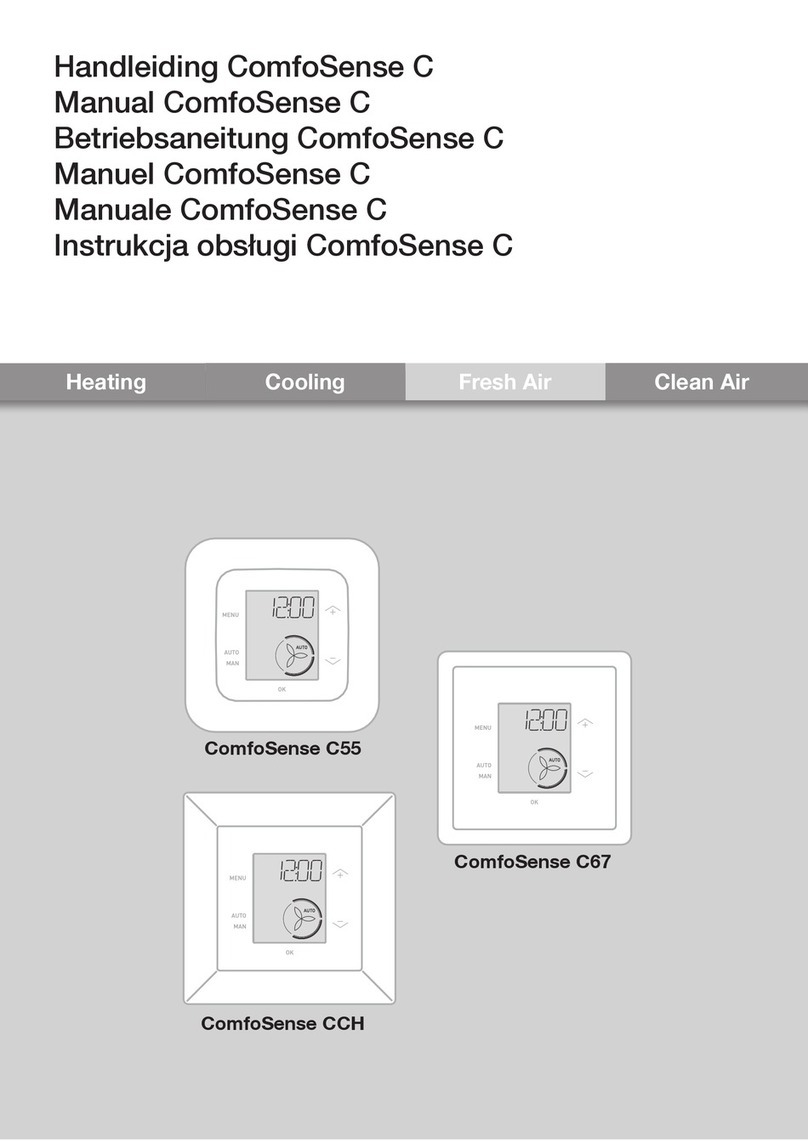
Zehnder Rittling
Zehnder Rittling ComfoSense C Series manual
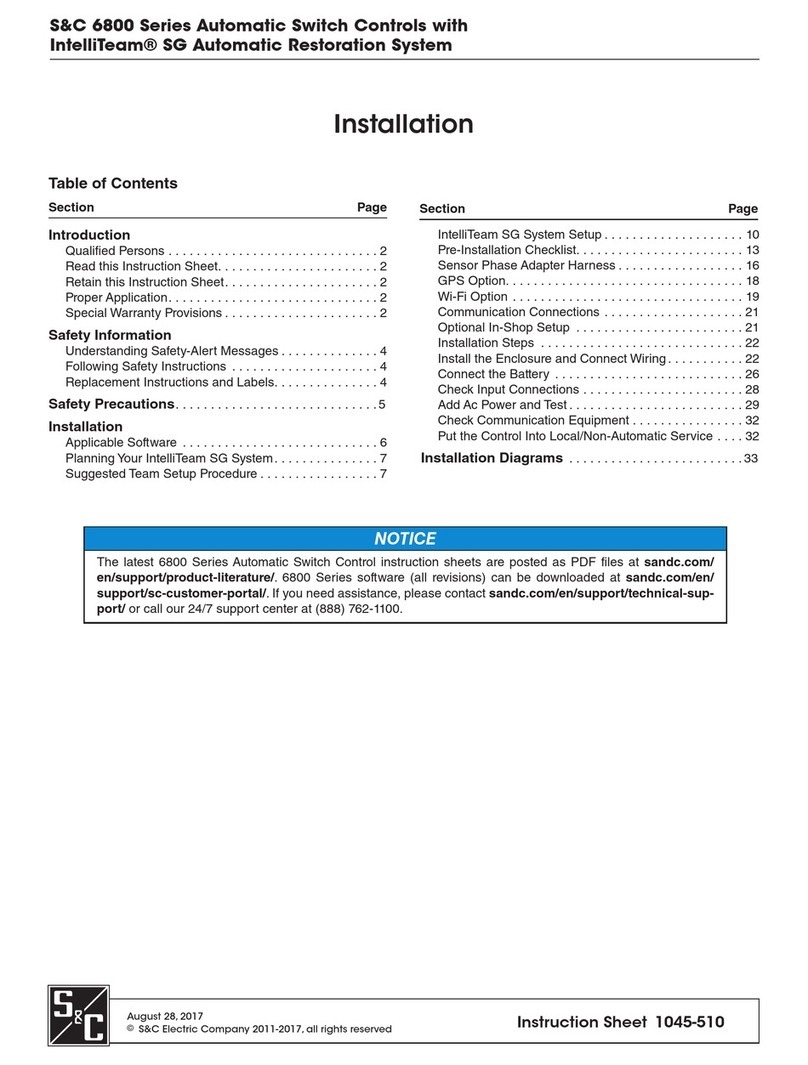
S&C
S&C 6800 Series instruction sheet
